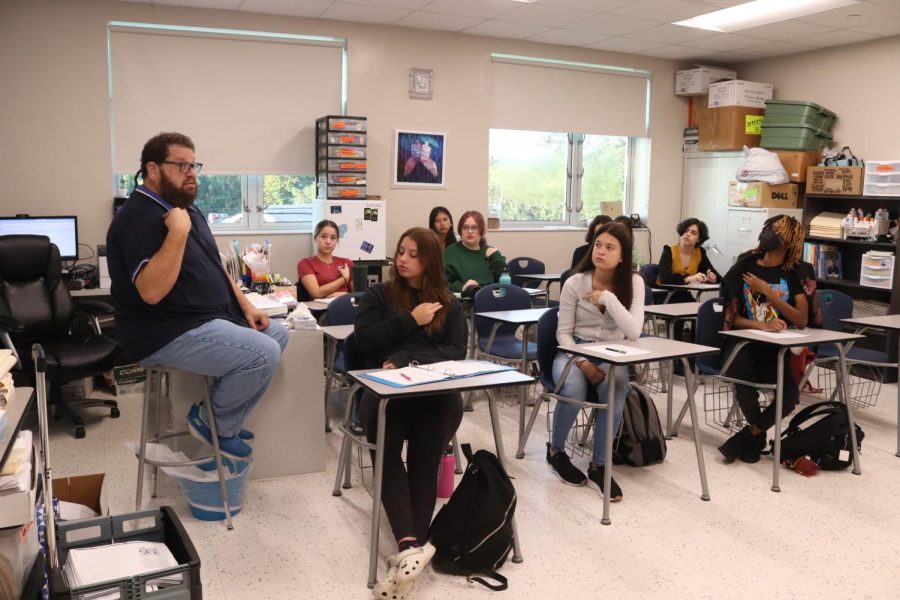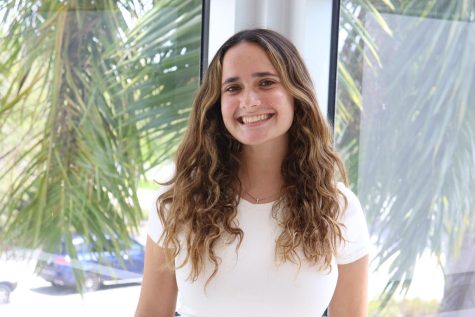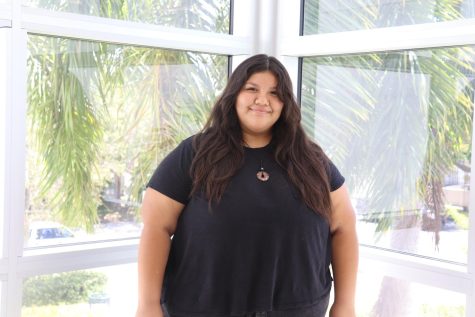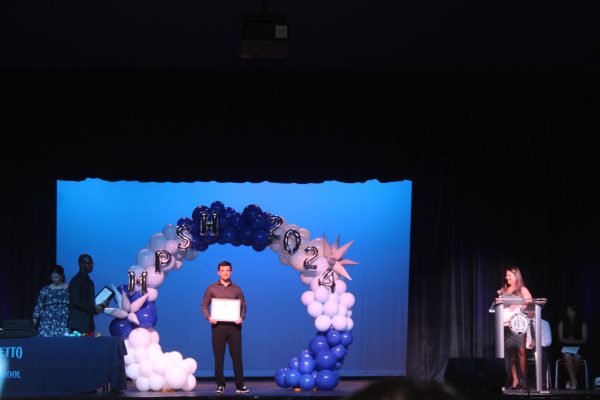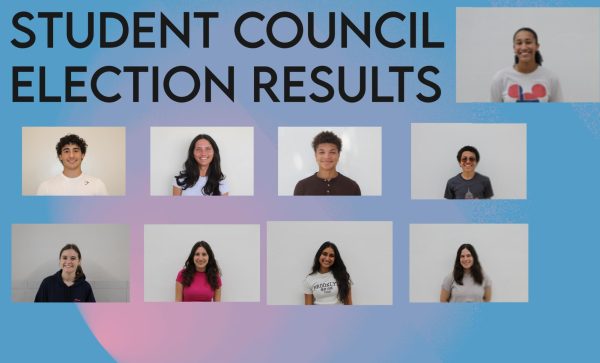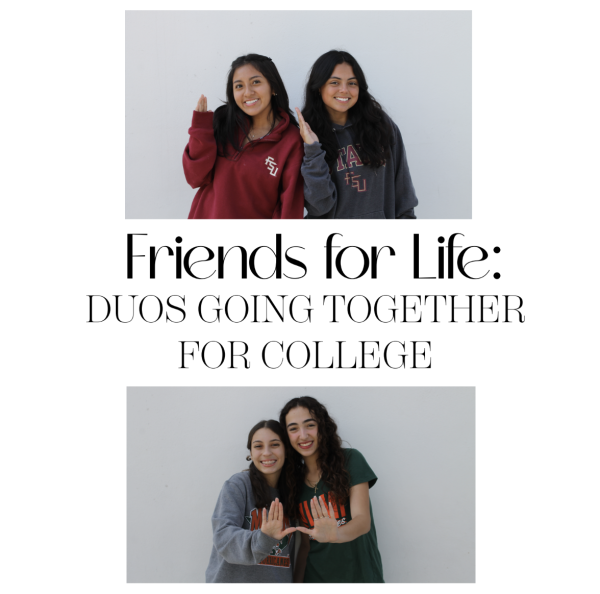Getting Hands-On with the American Sign Language Department
Miami Palmetto Senior High School teacher, Mr. Schwarz teaching his students ASL phrases.
September 19, 2022
Miami Palmetto Senior High offers six foreign language courses. Students flow in and out of class to learn conjugations, and the language’s culture— and perhaps fulfill their mandatory two-year language requirement for graduation. Requirements aside, many Palmetto students spend around half of their four years in a foreign language class and search for one that is worthwhile. American Sign language could be the answer for those seeking a new language, even if it does not require any speaking.
Palmetto offers three levels of ASL, ranging from ASL 1 to the most advanced ASL 3 class. Currently, the College Board does not offer an AP ASL test. Palmetto first began offering ASL classes in the late 1990s when the Special Education Chair gave Larry Schwarz, Palmetto alumni, the position of ASL teacher. While some incorrectly thought students could easily learn the language and fulfill their requirements, the addition of ASL to Palmetto challenged students with a new language and a deep culture.
“There are so many beneficial reasons to know ASL. Not only can you communicate with the deaf or hard of hearing, but you can also communicate with those who know sign language in situations where it might be near impossible to speak,” MPSH ASL teacher and ASL Club sponsor Bianca Mejias said. “It’s a language where people can’t help but look at you sign because it’s so mesmerizing to see. As well, American Sign Language is considered a language credit for most colleges, thus it’s great to have on school transcripts.”
Students learn the fundamental components like the alphabet and sentence structure, but they also learn about Deaf culture. Throughout history, deaf people and those who are hard of hearing have faced discrimination and misconceptions from hearing people. Schools have suppressed signing and instead promoted oralism and reading mouth shapes. Throughout time though, more schools for the deaf became established and a resurgence of Deaf pride began blooming.
“I was telling my students that as little as 10 years ago, there weren’t that many colleges that accepted sign language as a foreign language credit. And there weren’t that many that offered it. But now, that’s completely changed,” Schwarz said. “And sign language is approved for those things and all Florida public schools have it. In some of them, they even have deaf education programs and they have interpreter programs.”
As Deaf awareness week begins on Sept. 18-24, it will focus on promoting positive aspects of deafness, social inclusion and raising awareness of organizations that support the deaf community. At Palmetto, ASL classes teach these principals year-round.
“Spreading awareness about Deaf culture is huge. Deaf people have taken so much pride in their culture for many years. It’s wonderful just for students and others to know [what] deaf people go through on a daily basis and how different, yet fascinating it is compared to other cultures. Deafness goes beyond just being informed about the language, and that’s where deaf culture comes in,” Mejias said.
Students also have the opportunity to learn ASL and about Deaf culture by joining the ASL club at Palmetto. The ASL club celebrates Deaf culture and the importance of language.
“Deaf people live in the hearing world and people that are hearing, like myself, tend to ignore deaf people and just completely disregard them. Not them personally, but disregard the fact that they can’t hear. People don’t make an effort to sign, or to learn sign, or to try to communicate with them, which I think is really important. So I think we should make more of an effort to be able to communicate with all different kinds of people,” ASL Club President and MPSH senior Alana Ramana said.
Meetings are on the second Thursday of the month in room 3206. Students can join without any knowledge of ASL and club members plan to teach the basics of ASL through several activities. The club also promotes Deaf culture through movies, holiday parties and games.
Club members also prepare for their upcoming showcase throughout the year, where they sign holiday songs or accompany a performance. Currently, the program works to perfect their performances for several special events.
“The ASL classes this year are definitely planning on having signed performances throughout the school year. We want to make ASL as known as possible. We are currently working on our performance for Panther Prowl,” Mejias said.
Aside from the club, Palmetto students enrolled in the class learn the meaning of signs and their history. For example, the sign for father, uncle and nephew takes place at the top of the head, while female words are signed at the chin. These signs— developed centuries ago— have a sexist connotation, referencing how a woman tied a bonnet at the chin and dealt with the feeding in the house. In contrast, society viewed men as the “thinkers” explaining their signs taking place at forehead level. The history behind certain signs further exemplifies its deep culture and complexities.
“So, obviously, I expected to learn the signs and stuff but what Mr. Schwartz does is he also teaches you the history of the signs, why some signs are the way they are… so we learned about the history of it, too. So, it wasn’t just the language because it has culture behind it,” MPSH junior and ASL 3 student Daniella Bustamante said.
As with any language, connecting the dots and grasping the sentence structure makes all the tests and quizzes worthwhile. Because ASL’s sentence structure differs from that of the spoken English language, signing full sentences marks a big accomplishment for students.
“It was really exciting. I mean, I had been wanting to learn sign language for years before. It is hard to do it on your own. So I was super excited for the class. And I felt like ‘oh my god, progress.’ I tried so hard on my own; before I knew the ABCs and the basics, but to be able to actually form sentences or words and to understand the teacher was super exciting,” Bustamante said.
Not only during Deaf awareness week, but every day, people continue to learn about ASL and Deaf culture. Whether it takes place in the classroom, at club meetings or watching popular media productions with deaf characters like “Switched at Birth” or “Coda,” the Deaf community continues to break barriers and demonstrate their capabilities.
“I want people to be able to relate to people who are not like them out in the world. And to appreciate the fact that people are different. But they’re also accessible just because they’re from a different culture, or different language, a different community, or they have a different way of thought, or different faith, that it’s the openness, the willingness to be open to somebody else that is extremely important. So we need to have that out in the real world,” Schwartz said.



